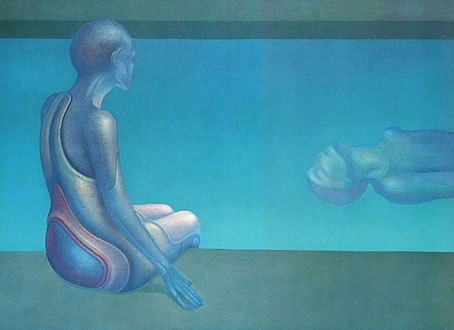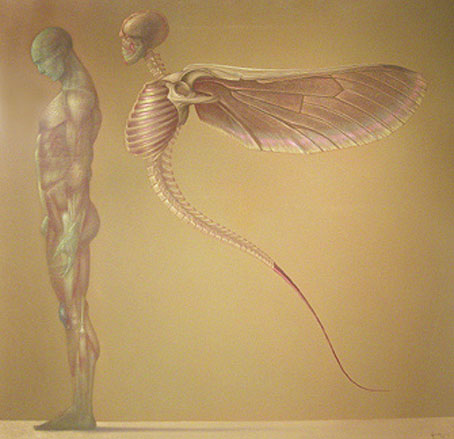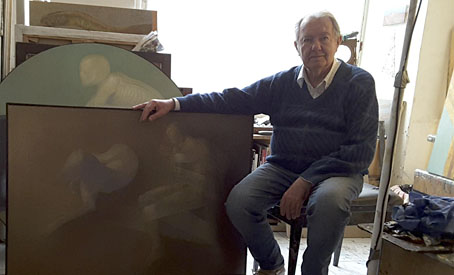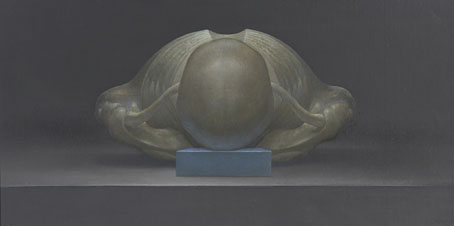
Deux Personnages (1974).
Jan of JKK Fine Arts was in touch this week to inform me that the French artist Michel Henricot died in February, a month before the opening of an exhibition of his work organised by JKK Fine Arts for the International Cultural Centre in Cracow, Poland.

Le Voyageur IV (1996).
I first encountered Henricot’s work in the pages of OMNI magazine where he was one of several featured artists who can be grouped together as “fantastic realists”—Ernst Fuchs, Mati Klarwein, HR Giger, Robert Venosa, Rudolf Hausner, De Es Schwertberger—although the label wouldn’t have necessarily been agreed to by any of them apart from Fuchs and Hausner, both of whom were members of the Vienna School of Fantastic Realism in the 1960s. Henricot’s sombre and obsessive figure studies were a good fit for the magazine, with the science fiction context lending his paintings suggestions of the futuristic or alien that might otherwise be absent in the empty space of an art gallery.

The artist photographed by Jan K. Kapera.
Despite such a high-profile showcase Henricot’s work has never been as visible as his more famous contemporaries so I’m grateful to Jan for supplying additional information, including the artist’s actual birth date, 8th July, 1936, rather than the erroneous dates found all over the internet. Henricot was friends with Leonor Fini, an artist whose work was also preoccupied with the human figure, often just as stylised and set against featureless monochrome backgrounds. Like Henricot, Fini’s art gets tagged as Surrealist even though her own obsessive paintings evolved away from any particular school. Henricot’s Les Promeneuses (1954) was definitely reaching for a Dalínean/Delvaux-like quality, but if his mature work belongs anywhere it’s with that small collection of French artists who don’t comprise any defined movement but who share a taste for the fantastic, the strange and the inexplicable: Sibylle Ruppert, Jean-Marie Poumeyrol, Jean-Pierre Ugarte, Gérard Trignac, Erik Desmazières, Jean-Paul Faccon, Pierre Clayette, Raymond Bertrand, Roland Cat, Gilles Rimbault, Jean-Michel Mathieux-Marie, and others. If I was given the opportunity to put together an art show for a French gallery (or even the Pompidou Centre…), these are some of the artists I’d choose.

Le Silence (1979).
Henricot will be running at the International Cultural Centre, Cracow, until the end of April.
Elsewhere on { feuilleton }
• The fantastic art archive
Previously on { feuilleton }
• Saint Sebastian in NYC
• The art of Michel Henricot

Thank you so much for posting this! As a kid who grew up in the dark Texas suburban wasteland (I think I’m approx. the same age as you), I had the same experience of seeing Michel Henricot’s art reproduced in Omni. I remembered his name, and in art school, when required to do a drawing in the “manner of your favorite artist,” I used Henricot. Of course, no one else knew who he was. It was the first time I became aware of the biased separation between “mere illustration” and “fine art.” Every now and then I’ll google “Michel Henricot” and look at what’s on line, as I did this morning, only to see news of his death on your post. I’d never seen a photo of him, and knew very little about his life. He was very nearly as old as my father, who also passed recently. Theirs was a generation that gave us a great deal, but seemed content with the self-evident achievement of their, perhaps, small but undeniable genius. I am glad to have shared the world with his luminous paintings.
Thanks, Bret. I was the same with many of those OMNI artists, I think I encountered all of them for the first time in the magazine, Giger included since he was in there before Alien introduced his art to a wider public. I’ve always been grateful to Bob Guccione or Ben Bova or whoever it was that made the decision to use that kind of art rather than generic SF illustration.